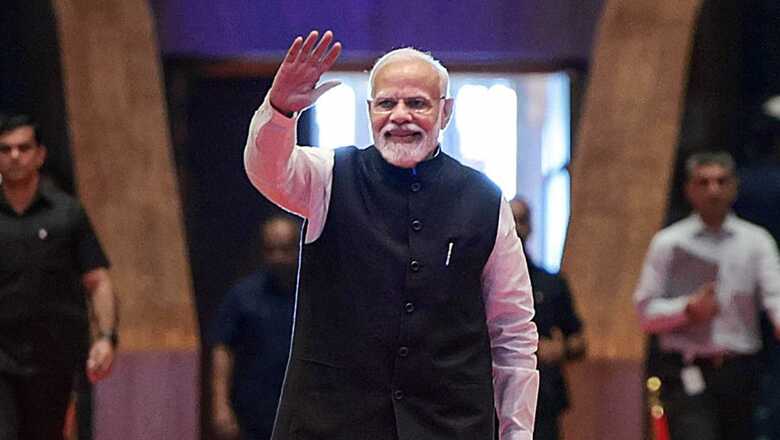
views
Since the swearing-in of Prime Minister Narendra Modi on May 26, 2014, India has experienced a significant shift in its political landscape. The initial tremors of this seismic shift were felt during his tenure as the chief minister of Gujarat. In this article, I will not only address the political consequences of Modi’s time in office but also the diplomatic implications on the global stage.
The Bharatiya Janata Party (BJP), which had been struggling to achieve a majority in the Indian political landscape for years, gained prominence in 2014, winning decisively in the general elections with Narendra Modi as the key factor behind this triumph. Few could have envisioned that the number 282 would emerge as a formidable roadblock for the Congress in the years to come. Since assuming the role of prime minister, Modi has emerged as one of the most assertive, dominant, and productive leaders in India’s history. In 2015, he surged six places from the previous year, ranking as the ninth most influential leader in the world.
Being recognised as one of the most influential and frequently searched leaders on the internet comes with its share of responsibilities, successes, setbacks, and failures. In the same year, then-US President Barack Obama was the Chief Guest at the Republic Day Parade in New Delhi. During the event, Congress Vice President Rahul Gandhi coined the phrase “Suit Boot Ki Sarkar” to describe Modi’s government.
India also climbed to the top of the Foreign Direct Investment (FDI) rankings, surpassing both China and the US, and improved its ranking on the World Bank’s Ease of Doing Business index by 12 positions. Despite these accomplishments, Modi faced challenges in state elections in Bihar and Delhi.
From Manchester to Wembley, India moved from being an outsider to reclaiming its position on the global stage. Modi transitioned from winning a majority to dreaming of transforming India into a global superpower, all while amassing a significant diplomatic record. This remarkable journey wasn’t solely the result of policy and agendas but was substantiated by 51 trips to 42 nations worldwide. In his first two years in office, Modi demonstrated that he was not a leader to engage in empty rhetoric or follow in the footsteps of his predecessors.
This was evident in his August 15, 2016 speech where he criticised Pakistan for supporting cross-border terrorism and expressed support for the Baloch Freedom Struggle and the people of Gilgit and Pakistan-occupied Kashmir (PoK). He also appealed to the youth of Jammu and Kashmir to abandon violence and pursue constructive paths to fulfill their dreams. In response to Modi’s speech, Pakistan’s Foreign Secretary delivered a letter to the Indian High Commissioner in Islamabad, inviting S Jaishankar to Pakistan for talks on the Jammu and Kashmir issue. This firm stance towards Pakistan garnered international attention and praise for eschewing the rhetoric of dialogue and reconciliation.
Notably, Modi’s demonetisation policy in November 2016 was seen as a setback for his government in future elections. The aftermath of the Uri attacks led to a surgical strike in PoK by the Indian Army, a display of India’s new approach that surprised the world.
Moving into 2017, the inauguration of Donald Trump as President of the United States marked a turning point in India-US relations, causing ripples in global geopolitics. When Modi visited the US, his first meeting with Trump emphasised the importance of peace, stability, and security in the Indo-Pacific region. Both leaders pledged to cooperate in combating terrorist safe havens, leading Trump to remark that India-US ties had never been stronger. This partnership led India and the US to stand united against terrorism. In 2018, India implemented the Ayushman Bharat scheme and achieved complete electrification of the entire country.
A significant event occurred in February 2019 following the Pulwama attack in Jammu and Kashmir, when Pakistan attempted to exploit the situation for electoral purposes. Under Modi’s leadership, India not only held Pakistan accountable but also issued a stern warning, demanding the swift return of a captured fighter pilot. This message was directed not only at Pakistan but also at China, which supported Pakistan’s sponsorship of terrorism. Modi’s departure from traditional dialogue and his strong political response garnered international attention and praise.
In May 2019, Modi was re-elected as prime minister for a second term, embarking on Modi 2.0. He faced the weight of both his past achievements and the expectations of his first term. Within three months of his second term, he revoked the special status of Jammu and Kashmir, Articles 370 and 35-A. This move sent a clear message to Imran Khan and Nawaz Sharif, who had referred to Burhan Wani as a martyr in 2016, and it was well-received by many. While Modi received praise for this action, Imran Khan, in his UN General Assembly speech, warned of a potential bloodbath in Kashmir. While Khan sought support from China, Malaysia, and Turkey, Modi secured the backing of the UAE, Saudi Arabia, and four members of the UN Security Council, who deemed the decision an internal matter of India.
Amid these diplomatic developments, Modi was steadily strengthening India’s position, preventing external intervention in the Kashmir issue. This was further supported by Donald Trump. The Modi-Trump alliance in refusing to tolerate bullying garnered attention worldwide and displeased China, anti-Trump US leaders, China’s allies, Pakistan, Turkey, Malaysia, and others.
By restraining bilateral and multilateral negotiations, the influence of the Muslim world’s interference was diminishing. Modi, in partnership with Trump, was on a mission to make India great again. It’s worth noting that it wasn’t just Trump who aligned with Modi’s policies. In 2019, the UAE awarded Modi the Order of Zayed, the country’s highest civilian award. While Modi and Trump presented a united front against China, the cautious stance of the UAE and Saudi Arabia was further isolating Pakistan.
In the years 2020-22, with the decline of Donald Trump, China escalated tensions with India in the Ladakh and Arunachal regions, resulting in casualties on both sides. China’s attempt to encroach on Indian territory in the Galwan Valley after years of diplomatic efforts by both countries led to clashes between their armies. India’s resolute stance in facing Chinese troops at Doklam and Galwan only further antagonised China. As India rose to become a global power, recovering what had been lost in previous diplomatic missteps, China resorted to various tactics to assert itself in the Himalayan region and through Pakistan.
Not to forget the demonstration of strength in its recent standoff with Canada over the Khalistan row, firmly upholding its position and boldly navigating diplomatic and international pressures. India’s resolute stance and decisive actions in the face of the dispute showcased a departure from its previous diplomatic approaches, emphasising a heightened sense of geopolitical awareness. In essence, Modi’s handling of the recent standoff with Canada not only bolstered its position on the Khalistan issue but also highlighted a new era of diplomatic finesse and resilience in the face of international complexities.
Returning to the global political stage, it’s worth mentioning Time Magazine’s poster on Modi, labelling him as “India’s Divider in Chief” and the question: “Can India endure another 5 years of Modi’s government?” This poster, along with the topic of what unfolded for Modi in 2019, bears relevance in the context of the current Bangladeshi Prime Minister Sheikh Hasina and the hard power dynamics impacting democracy in Bangladesh. Such moves, orchestrated by the US against leaders not favoured by the deep state and corrupt power brokers, are a recurring pattern. Those who obstruct Washington’s pursuit of profit through global conflicts or create conditions for conflict in any nation become targets of the Regime Change Policy Conflict.
As the 2024 Lok Sabha elections approach, India will likely face challenges from allies and non-allies seeking to destabilise Modi’s leadership. These challenges may manifest as riots, radicalisation, polarisation, terrorism, and other means aimed at toppling Modi, who symbolises peace and the dissolution of conflicts that sustain industries built on turmoil.
India should now brace for an impact.
The author is an Engineer, former BJP Youth Wing Spokesperson, and a columnist. Views expressed in the above piece are personal and solely that of the author. They do not necessarily reflect News18’s views.















Comments
0 comment